Atmospheric Long-Range Transport of Urban Pollutants
LEONARD LEVIN
Electric Power Research Institute
Atmospheric processes, including the wind-borne transport of air pollutants, are typically classified into time and equivalent spatial scales, each of which includes dominant physical and chemical processes. For example, the “mesoscale-beta” spatial scale typically extends from 200 to 2,000 km in space and from six hours to two days in time. Dominant processes at this scale are land-sea differences in heating, large topographic features, and atmospheric centers of action (or high and low pressure systems and the frontal patterns between them). The equivalency of time and space imply mean wind speeds of about 30 km/h for transport of material, representing frontal pattern transport rather than geostrophic motion of centers of action.
Long-range transport of pollutants is generally taken to mean transport over spatial scales in the mesoscale-beta range or larger. During this transport, the pollutant(s) of primary interest, as well as the co-pollutants transported with them, may undergo chemical and photochemical transformation. Methods of relating pollutant levels measured at distant receptor points to their area of origin and transport route vary widely. One method uses co-pollutant tracers; for example, elevated sulfate levels may indicate an industrial source zone and “tag” the location of origin for co-transported mercury. Selenium is used as an indicator for oil or coal combustion, and elevated levels of selenium are commonly used to “tag” chromium or nickel.
Global industrial development has resulted in concentrations of energy, production, and commercial facilities in urban areas and consequent concentrations of emissions of complex suites of organic and inorganic atmospheric pollutants into general atmospheric circulation. This paper is an overview of the
teleconnections between densely populated areas via the transport of emitted pollutants. Urban areas are (1) significant source areas for pollutants in distant receptor points and (2) receptor areas for pollutants originating at great distances that often have a significant effect on the baseline air quality in the receptor areas.
LONG-RANGE TRANSPORT AND URBAN AREAS IN CHINA
Over the last decade, a number of international bodies, such as the International Institute for Applied Systems Analysis (IIASA) and the United Nations Environment Program (UNEP), have accumulated a body of data and model results demonstrating the significant contributions of combustion and mobile sources in China to air quality at distant points. Data collected throughout the 1990s and the first part of this century have shown the predominance of urban sources for a wide range of pollutants. For example, during the multinational ACE (Asian Pacific Regional Aerosol Characterization Experiment)-Asia experiment in 2001, Clarke et al. found that aerosol measurements over the Yellow Sea indicated the presence of large urban areas upwind; the highest values of both light scattering and absorption occurred below 1 km elevation, becoming moderate scattering but high absorption between 1 and 4 km, and dropping off rapidly above 4 km. This pattern of light modification is characteristic of high concentrations of both primary (large) and secondary (smaller, < 0.75µm) aerosols in the lowest layer, a signature of urban emissions from combustion and vehicular use; the middle layer shows chiefly larger primary particles, potentially representing elevated emissions from combustion sources.
Numerous incidents have been reported of Asian contributions to particulate matter or ozone on the western boundary of North America, some of them attributable to increased emissions from or greater production downwind of urban areas in Asia (Holloway et al., 2003). Recent data are compiled in Tables 1 and 2.
Asia, particularly China, is more problematic as a receptor area for emissions from other continents, partly because of the quantity of emissions just upwind of the Asian landmass, partly because of the monsoonal circulation created by the size of that landmass, and partly because of the large-scale general circulation of the global atmosphere.
Generally, China is in the downwind direction of sources in the prevailing mid-latitude westerlies, but somewhat south of the path of centers of action that redistribute either persistent pollutants or secondary products. South China lies astride the “horse latitudes” marked by generally easterly flow, specifically the western extension of the El Nino-Southern Oscillation (ENSO) pattern of the cisequatorial Pacific basin. Monsoonal patterns over east Asia contribute to the strong transport of emissions from industrialized Europe to the northeast. Lester Machta of the U.S. National Oceanic and Atmospheric Administration noted high levels of sulfates in the (then) Soviet arctic north of the Yenisei River delta and
TABLE 1 Surface Aerosol Increases at Northern Mid-latitudes from Intercontinental Transport of Pollution
|
Source Region |
Receptor Region |
Aerosol Type |
Aerosol Enhancement above Long-Term Baseline (µg/m–3 unless stated otherwise) |
Method of Estimate |
|
Asia (mean) |
U.S., yearly means |
organic carbon |
0.013 (western U.S.) 0.007 (eastern U.S) |
Sensitivity simulation with no anthropogenic emissions from source region. |
|
Elemental carbon |
0.005 (western U.S.) 0.003 (eastern U.S.) |
|
|
|
|
Asia (events) |
Northwestern U.S., spring 1997 |
all |
~200 particles cm-3 |
Observed enhancements at Cheeka Peak Observatory in air masses of Asian origin. |
|
Asia (dust event) |
Western U.S., April 1998 |
all |
40–63 (PM10), 4–11 (PM2.5) |
Observed enhancements at a number of monitoring stations. |
|
Asia (dust event) |
Lower Fraser Valley, British Columbia, Canada, April 1998 |
all |
18–26 (PM10) |
Attribution based upon elemental composition at a number of monitoring stations. |
|
Asia (dust event) |
Northwestern U.S., April 1993 |
all |
4–9 (PM10) |
Observed enhancements at three monitoring stations. |
|
Asia |
Western U.S., spring, summer, fall 1989–1999 |
all |
0.2–1 (PM2.5), rare exceedances of 5 |
Attribution based upon matching Asian source type (diagnosed from April 1998 events) via cluster analysis at a number of monitoring stations. |
|
Source: Holloway et al., 2003, and references therein. |
||||
TABLE 2 Surface Ozone Enhancements at Northern Mid-latitudes from Intercontinental Transport of Pollution
|
Source Region |
Receptor Region |
O3 Enhancement (ppbv) |
Method of Estimate |
|
Asia |
Northwestern U.S., spring |
4 (mean), 7.5 (max) |
Sensitivity simulation with no anthropogenic emissions from source region. |
|
Asia |
Western U.S., spring |
3–10 (range during Asian pollution events) |
Sensitivity simulation with no surface emissions from source region. |
|
Asia |
Europe, U.S. |
1.0 (U.S.), 0.8 (Europe) |
Annual mean enhancements from sensitivity simulations with 10 percent increases in emissions from source region. Results were multiplied by 10 to estimate total effect of current anthropogenic emissions from the source continent. |
|
Europe |
Asia, U.S. |
1.1 (Asia), 0.9 (U.S.) |
|
|
U.S. |
Europe, Asia |
2.0 (Europe), 0.8 (Asia) |
|
|
Asia and Europe |
U.S., summer |
4–7 (typical afternoon range), 14 (max) |
Sensitivity simulation with no anthropogenic NOx and non-methane VOCs emissions from source region. |
|
Europe |
East Asia, spring |
3 (daytime mean) |
Ibid. |
|
North America |
Europe, summer |
2–4 (daytime mean), 5–10 (events) |
Ibid. |
|
Europe |
East Siberia |
2 (annual) 3 (spring-summer) |
Difference between median observed O3 concentrations in 1997–1999 for air masses originating in Europe vs. Siberia and high latitudes. |
back-trajectory analysis to their sources in Central Europe (personal communication). As noted by Martin (2003):
Modelling studies suggest that the relative contribution of emissions sources on other continents to annual mercury deposition is largest for North America, less for Europe, and lowest for Asia, which is primarily due to the spatial pattern of emissions.
|
Source Region |
Receptor Region |
O3 Enhancement (ppbv) |
Method of Estimate |
|
North America |
Mace Head, Ireland |
0.4 (winter) 0.2 (spring) –0.3 (summer) –0.9 (fall) |
Mean observed difference in O3 concentrations in 1990–1994 for air masses originating in the U.S. and Canada vs. Iceland and Greenland. |
|
North America |
Europe, yearly mean |
18 (Atlantic fringes) 10–15 (central Europe) |
Ozone produced in tropospheric column over source region. |
|
Asia |
Europe, yearly mean |
9 (Atlantic fringes) 5–7 (central Europe) |
|
|
Background (anthropogenic methane) |
U.S., summer |
6 (afternoon mean) |
Sensitivity simulation with anthropogenic CH4 emissions reduced globally by 50%. O3 enhancements from that simulation were doubled to estimate total enhancement from anthropogenic CH4. |
|
Background (1980–1998) |
U.S. |
3–5 (spring, fall) |
Observed trend in the lower quantiles of the O3 frequency distribution at rural sites. |
|
Background (1984–2002) |
U.S. west coast |
10 |
Observed trend at surface sites and from aircraft missions (1984–2002). |
|
Asia (future) |
U.S. |
2–6 (western U.S.) 1–3 (eastern U.S.) highest in April–June |
Sensitivity simulation with tripled Asian NOx and non-methane VOCs emissions. |
|
Asia (future) |
Western U.S., spring |
30–40 (max during Asian pollution events) |
Sensitivity simulation with quadrupled Asian emissions. |
|
Source: Holloway et al., 2003, and references therein. |
|||
MERCURY AS A TRACER SUBSTANCE
The development of sensitive, rapid-response instrumentation in the last five years has enabled us to consider using measurements of mercury as tracers for source regions and, in some cases, for source points. The widespread use of the Tekran™ device allows ground and aircraft measurements of total gaseous mercury (TGM) and speciated mercury at ambient levels in the environment. The Tekran instruments work by pumping ambient air with contained mercury vapor
into the analysis module. During part of each sampling cycle, at lower temperature, the reactive gaseous mercury (RGM) is captured on an annular denuder while the remaining elemental mercury passes through the analyzer; during a desorption phase at higher temperature (500°C), the analyzer alone pumps at a lower rate while the RGM is driven off the denuder and reduced, allowing measurement of the RGM portion of TGM.
Because of the relatively slow reaction rate of mercury in the atmosphere, mercury measurements can be used to track occurrences of higher mercury concentrations above background, both downwind to receptor regions and upwind to source regions. Mercury can thus be considered a conservative tracer substance, at least in the atmosphere.
Because of its complex biogeophysical cycling, however, there is as yet no good way to use mercury as a tracer from an atmospheric source to its ultimate uptake by food fish in the upper trophic level. There is some evidence that naturally occurring, lighter, stable isotopes of mercury may become slightly enriched through natural cycling due to the high vapor pressure of elemental mercury in aqueous environments (EPRI, 1998). William Landing of Florida State University is currently working to compare natural isotope ratios of mercury in coal at operating power plants with ratios in nearby waterways.
The Asian continent as a whole, and China in particular, is currently the single largest source of mercury emissions to the atmosphere from human activity (Pacyna et al., 2002). Table 3 shows this dominance. It is estimated that China contributes 500 Mg (1 Mg = 106 g = 1 metric ton [MT]) of total mercury from small, distributed industrial furnaces and village-level coal burning alone, or about 25 percent of the global emissions from anthropogenic sources.
During 2001, components of the ACE-Asia experiment were carried out jointly by agencies of the United States, Japan, Canada, South Korea, and China. One component of this extensive study was a mercury-tracking experiment by Electric Power Research Institute (EPRI), carried out by scientists of the National Center for Atmospheric Research (NCAR), in Boulder, Colorado. In this experiment, an NCAR C-130 aircraft equipped for extended high-altitude flight and using a Tekran 1130 analyzer sampled concentrations of TGM while flying transects off the east coasts of Japan and south China. During these flights, cotracer substances characteristic of presumed source categories were also measured.
Figure 1 shows the suite of research flights undertaken in the NCAR C-130 aircraft. Figures 2 and 3 illustrate a transect of the emission plume from the Miyake Jima volcano, a natural background source on the east coast of Honshu Island, Japan. Joint measurement of sulfur dioxide (SO2) using a fast-response SO2 analyzer illustrates the center of the plume. The “square wave” pattern of mercury concentrations is due to the integration time of the Tekran analyzer.
Figure 4 illustrates the signature pattern of a mix of urban air emissions from the industrialized area of southeast China near the city of Shanghai. These
TABLE 3 Global Emissions of Mercury from Anthropogenic Sources for 1995 (in metric tons = 106 g)
|
Continent |
Stationary Combustion |
Non-ferrous Metal Production |
Pig Iron and Steel Production |
Cement Production |
Waste Disposal |
Total |
|
Europe |
185.5 |
15.4 |
10.2 |
26.2 |
12.4 |
249.7 |
|
Africa |
197.0 |
7.9 |
0.5 |
5.2 |
|
210.6 |
|
Asia |
860.4 |
87.4 |
12.1 |
81.8 |
32.6 |
1,074.3 |
|
North America |
104.8 |
25.1 |
4.6 |
12.9 |
66.1 |
213.5 |
|
South America |
26.9 |
25.4 |
1.4 |
5.5 |
|
59.2 |
|
Australia/Oceania |
99.9 |
4.4 |
0.3 |
0.8 |
0.1 |
105.5 |
|
TOTALa |
1,474.5 |
165.6 |
29.1 |
132.4 |
111.2 |
1,912.8 |
|
aIn addition, emission of about 514 metric tons of mercury was estimated from chlor-alkali plants, gold production, and mercury used for various purposes (e.g., primary battery production, production of measuring and control instruments, production of electrical lighting, wiring d evices, and electrical switches, etc.) in 1995. Source: Pacyna et al., 2002. |
||||||
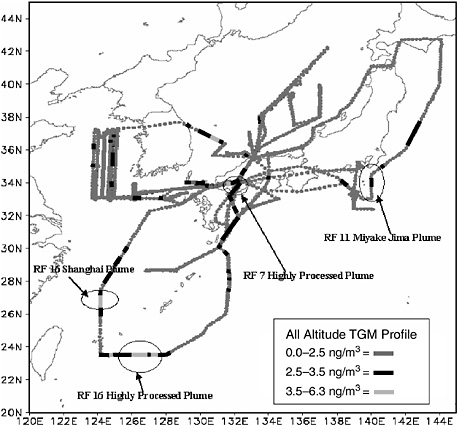
FIGURE 1 GIS-located flight tracks for the 2001 ACE-Asia Experiment mercury runs by NCAR C-130 aircraft. Circled segments indicate the plume of TGM from Shanghai, China, “aged” by residence in the marine boundary layer during over-water fetch. TGM concentrations in circled segments range from 3.5 to 6.3 ng/m3 TGM (integrated over air column).
indications of source strength and characteristics were extended out into the Pacific basin. Figure 5 is a depiction of the three-dimensional structure of the research flights east of the south China coast, which were able to track the Shanghai urban plume for some 600 km over the Pacific.
As significant as these findings were, the receipt of the plume material on the west coast of North America remained to be investigated. In May 2003, flights were undertaken from Monterey, California, on a transect offshore California, Oregon, and Washington state (Friedli et al., 2004). Figure 6 illustrates simultaneous measurements of altitude above sea level, TGM in ng/m3, and carbon
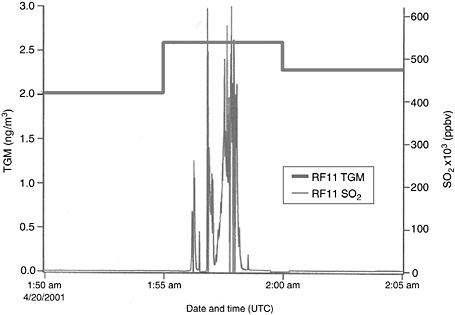
FIGURE 2 Instrument traces for TGM and SO2 during transect of downwind plume from Miyake Jima volcano, Honshu Island, Japan, April 20, 2001. Response time for SO2 sensor (95 percentile rise time) was typically 10 ms. Integration time for Tekran 1130 gaseous mercury sample was five minutes.
monoxide (CO, a tracer for urban area plumes) in parts per billion volume (ppbv). The Shanghai mercury plume is evident in the marine boundary level, even at these distances, some 1.6 × 104 km from the source.
An even higher concentration of mercury is evident at some 8,000 feet of elevation. Figures 7 and 8 show back-trajectory calculations indicating the originating region of the lower plume as the south China Sea; the upper plume is traced as far as central Asia. Additional data for this higher-elevation plume might have allowed tracking of the plume origins further west on the Eurasian land mass, perhaps to source regions in eastern Europe (there are no known high emission rate mercury sources in central Asia).
CONCLUSIONS
In recent years, researchers have noted numerous instances of both transatlantic and transpacific transport of marker pollutants. Measurements have been made of crustal material from Central Asia and the Sahara, ozone resulting from the photochemical transformation of precursor material from Asian urban regions,
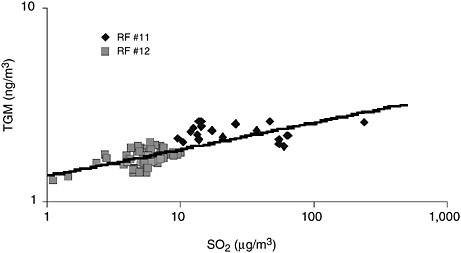
FIGURE 3 Correlation between SO2 in µg/m3 and TGM in ng/m3 for the Miyake Jima volcano, demonstrating the close correlation between the two for this set of two research flights and the potential for tracking mercury from this category of background source in isolated locations.
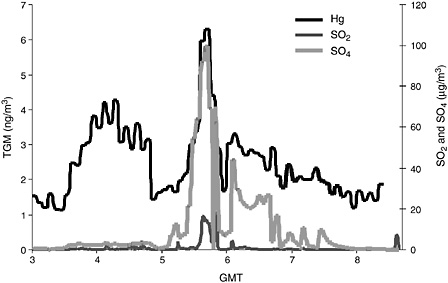
FIGURE 4 Instrument traces for SO2, SO4, and TGM downwind to Shanghai, China. Mercury (topmost trace) scale is on left vertical axis; sulfur species are on right axis. Note the difference in time scale from Figure 2.
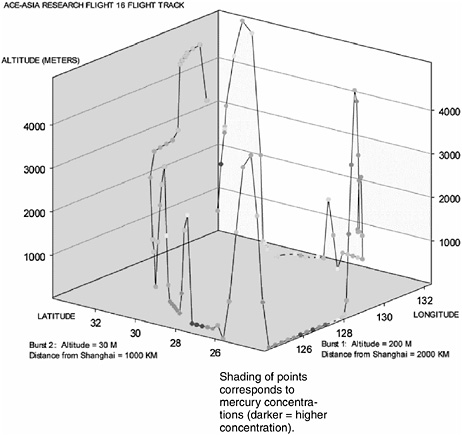
FIGURE 5 Demonstration of Shanghai plume “aging” in marine boundary layer. Three-dimensional depiction of flight track over the southwestern North Pacific tracking a mercury plume from Shanghai, China. Colors of data points represent concentrations of TGM.
and particulate matter with associated urban marker substances across the tropical Atlantic. With recent advances in measurement methods and sample analysis, mercury can be used as a tracer for source areas far upwind, in some cases across the Pacific.
Measurements by aircraft in 2001 and 2002 were able to track mercury from emission regions in industrialized southeast China, near Shanghai, and later detect the same mix of mercury and co-pollutants penetrating the west coast of the United States. Based on co-emitted characteristic co-pollutants, these measurements were able to discriminate between urban anthropogenic sources of mercury and background natural sources. As the discrimination of stable mercury isotope ratios improves, these methods may be combined to allow subcategorization of
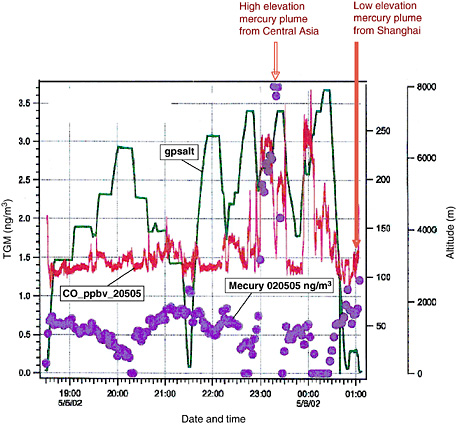
FIGURE 6 Evidence of dual mercury plumes from Asian landmass penetrating west coast of United States, May 5–6, 2002 (hours zulu), transect off San Diego, California, north to mouth of the Columbia River, Oregon/Washington. Mercury in ng/m3 on left scale, CO in ppbv on inner right scale, altitude MSL in meters on outer right scale. Source: Friedli et al., 2004.
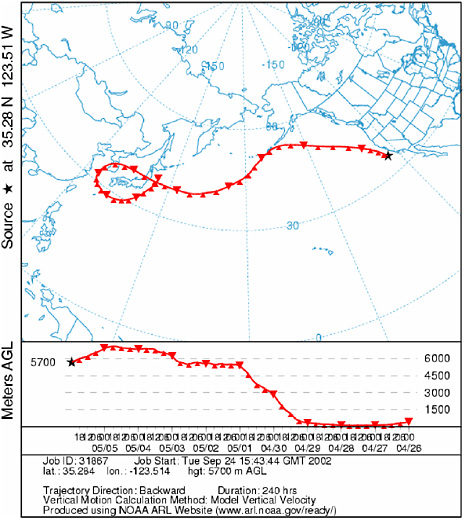
FIGURE 7 Back-trajectory calculations by U.S. National Oceanic and Atmospheric Administration for lower urban mercury plume, 10-day traverse of North Pacific from South China Sea/Sea of Japan origin region (backward trajectory ending at 23 UTC 05 May 02, FNL meteorological data). Note lofting of plume centerline at approximately day four due to intrusion of colder marine air mass in central North Pacific.
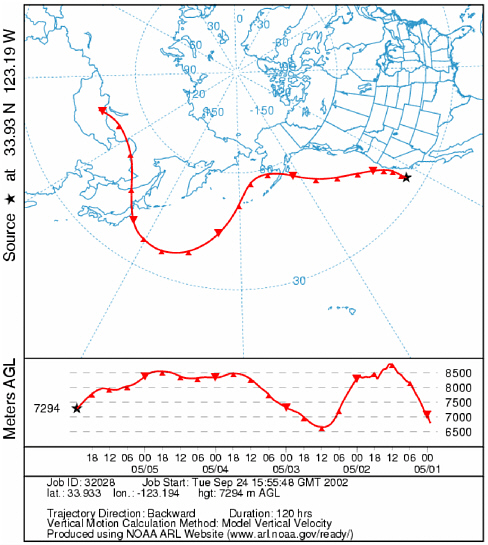
FIGURE 8 Back-trajectory calculations by the National Oceanic and Atmospheric Administration for upper Central Asia mercury plume, five-day traverse of eastern China and North Pacific from Mongolian plateau origin region (backward trajectory ending at 23 UTC 05 May 02, FNL meteorological data). Data limitations on wind structure in west-central Asia are presumed to limit further distinction of plume traverse from potential source regions further west in Eurasia. Note change in vertical scale on lower left altitude trace; the plume origin height is consistent with a source in central Asia (within data limits). Drop in elevation at approximately day two is consistent with entrainment into cyclonic area in western Pacific. Source: Friedli et al., 2004.
sources from distant measurement locations and improved source-receptor analyses for suites of pollutants.
REFERENCES
Clarke, A.D., Y. Shinozuka, V.N. Kapustin, S. Howell, B. Huebert, S. Masonis, T. Anderson, D. Covert, R. Weber, J. Anderson, H. Zind, K.G. Moore II, and C. McNaughton. 2001. Size-Distributions and Mixtures of Black Carbon and Dust Aerosol in Asian Outflow: Physiochemistry, Optical Properties, and Implications for CCN. Available online at: http://saga.pmel.noaa.gov/aceasia/pubs/ClarkeLightAbsTrAATxtMar03.pdf (accessed April 15, 2004).
EPRI (Electric Power Research Institute). 1998. The Use of Stable Mercury Isotopes and Surrogate Tracers to Investigate Source-Receptor Relationships. Report TR-111977. Palo Alto, Calif.: EPRI.
Friedli, H.R., L.F. Radke, R. Prescott, P. Li, J. Woo, and G.R. Carmichael. 2004. Mercury in the atmosphere around Japan, Korea, and China as observed during the 2001 ACE-Asia field campaign: measurements, distributions, sources and implications. Journal of Geophysical Research 109(D19S25). Available online at: http://www.agu.org/journals/jd/jd0416/2003JD004244/2003JD004244.pdf.
Holloway, T., A. Fiore, and M.G. Hastings. 2003. Intercontinental transport of air pollution: will emerging science lead to a new hemispheric treaty? Environmental Science and Technology 37(20): 4535–4542.
Martin, H. 2003. The Long-Range Transport of Toxics into the Great Lakes Basin: Current Scientific Understanding and Future Priorities. Prepared for the Great Lakes Binational Toxics Strategy Workshop Long-Range Transport Initiative, Ann Arbor, Michigan, September 16–17, 2003.
Pacyna, J.M., E.G. Pacyna, F. Steenhuisen, and S. Wilson. 2002. Mapping 1995 global anthropogenic emissions of mercury. Atmospheric Environment 37(Suppl. 1): S109–SA117.


















